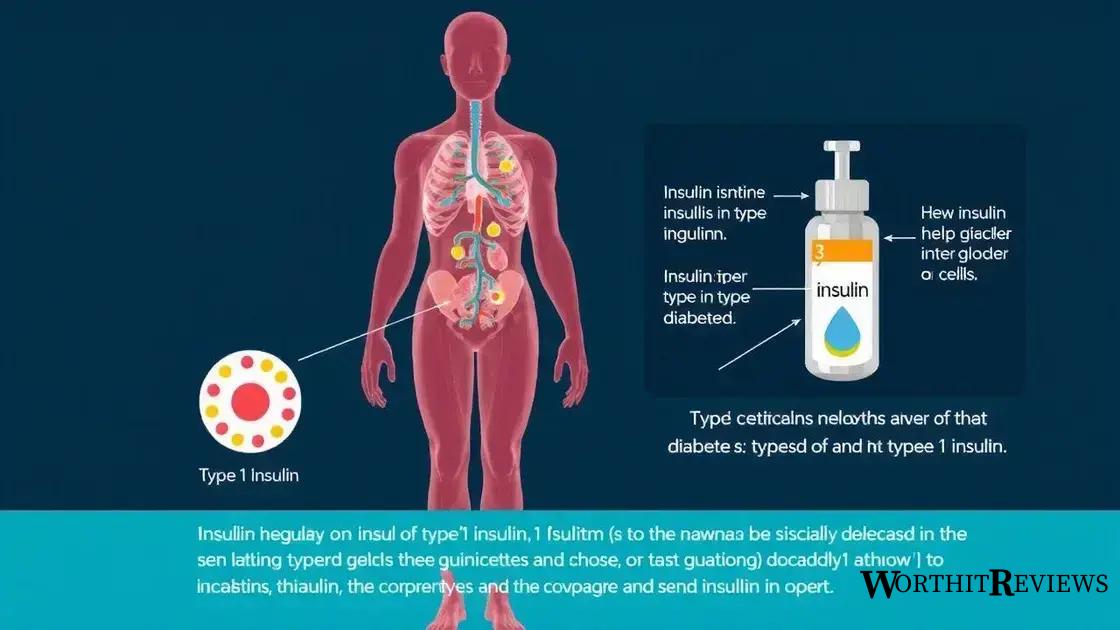Type 1 diabetes results from the body’s inability to produce insulin, requiring lifelong insulin therapy, while type 2 diabetes is characterized by insulin resistance and can often be managed through lifestyle changes and medications.
Type 2 diabetes and type 1 diabetes might sound similar, but they have distinct differences that affect millions of lives. Have you ever wondered how these two types impact daily routines and health?
Understanding type 1 diabetes
Type 1 diabetes is an autoimmune condition where the body attacks insulin-producing cells in the pancreas. This type of diabetes is often diagnosed in children and young adults, but it can occur at any age.
People with type 1 diabetes must rely on external insulin through injections or an insulin pump to manage their blood sugar levels. Unlike type 2 diabetes, which can sometimes be managed with lifestyle changes, type 1 requires continuous insulin use for survival.
Symptoms of Type 1 Diabetes
Common symptoms include increased thirst, frequent urination, extreme fatigue, and blurred vision. Many people may also experience sudden weight loss. Recognizing these symptoms early is crucial for timely intervention and management.
Causes and Risk Factors
The specific cause of type 1 diabetes is not fully understood, but it is believed to involve genetic factors and an irregular immune response. Family history may play a role as well, although most cases occur spontaneously.
Management Strategies
Effective management of type 1 diabetes entails regular monitoring of blood sugar levels, proper insulin dosing, and understanding how food and exercise affect glucose levels. Education is key; patients learn to balance their diet and activity with their insulin regimen.
Many individuals with type 1 diabetes lead full and active lives. With the right tools and support, they can effectively manage their condition.
What is type 2 diabetes?

Type 2 diabetes is a chronic condition that affects the way your body metabolizes sugar (glucose), which is crucial for energy. This type of diabetes occurs when the body becomes resistant to insulin or when the pancreas fails to produce enough insulin.
Unlike type 1 diabetes, which is usually diagnosed in children and young adults, type 2 diabetes more commonly appears in adults. However, rising rates of obesity have led to more cases in younger populations.
Symptoms of Type 2 Diabetes
The symptoms of type 2 diabetes can be subtle and develop gradually. Common symptoms include increased thirst, frequent urination, fatigue, blurred vision, and slow-healing wounds. Some individuals may not notice symptoms at all, which can delay diagnosis.
Causes and Risk Factors
The main causes of type 2 diabetes include excess weight, inactivity, and unhealthy eating habits. Genetics also play a role, as having a family history of diabetes increases your risk. Other risk factors include age, ethnicity, and certain health conditions such as high blood pressure.
Management and Treatment
Managing type 2 diabetes often involves lifestyle changes, like improving diet, engaging in regular physical activity, and maintaining a healthy weight. Medications or insulin therapy may be necessary if lifestyle changes alone are insufficient for maintaining blood sugar levels.
Regular monitoring of blood glucose levels is essential. Early diagnosis and proper management can help prevent complications such as heart disease, nerve damage, and kidney problems.
Symptoms of type 1 versus type 2 diabetes
The symptoms of type 1 diabetes and type 2 diabetes often share some similarities, but there are key differences between them. Both types can cause increased thirst, frequent urination, fatigue, and blurred vision.
Type 1 diabetes symptoms typically develop quickly, often within a few days or weeks. Individuals may also experience unexplained weight loss and a stronger sense of hunger. This rapid onset is due to the body’s inability to produce insulin.
In contrast, type 2 diabetes symptoms usually develop gradually over time. People might not realize they have the condition at first because the symptoms are often milder. Along with the common symptoms, type 2 diabetes can also lead to slow-healing sores and frequent infections.
Recognizing the differences in symptoms is crucial for timely diagnosis and treatment. For example, if someone is experiencing persistent symptoms and feels unusually fatigued, it is important to seek medical advice promptly.
Importance of Timely Diagnosis
Early diagnosis of either type can help manage the condition effectively and prevent complications. Blood tests can confirm diabetes and guide treatment options based on the type.
Management strategies for type 1 diabetes

Managing type 1 diabetes involves a combination of monitoring blood sugar levels, administering insulin, and making healthy lifestyle choices. Each individual may require different strategies to maintain optimal health.
One vital aspect of management is regular blood glucose monitoring. This helps individuals track their levels throughout the day and make appropriate adjustments to their insulin dosage and diet.
Insulin Therapy
Since people with type 1 diabetes do not produce insulin, they rely on insulin therapy. This can include multiple daily injections or the use of an insulin pump. Knowing when and how much insulin to take is crucial for keeping blood sugar levels stable.
Healthy Eating
A balanced diet plays a significant role in managing type 1 diabetes. Incorporating a variety of healthy foods, such as fruits, vegetables, whole grains, and lean proteins, can help maintain steady blood glucose levels. Counting carbohydrates and understanding how different foods affect blood sugar is important.
Physical Activity
Regular exercise is beneficial for everyone, especially those with type 1 diabetes. Physical activity can help improve insulin sensitivity and lower blood sugar levels. However, it is important to monitor blood sugar before, during, and after exercising to prevent hypoglycemia.
In addition to these strategies, it’s essential to stay informed. Joining diabetes education programs or working with healthcare providers can provide support and resources for managing type 1 diabetes effectively.
Lifestyle changes for managing type 2 diabetes
Making lifestyle changes is essential for effectively managing type 2 diabetes. These changes can help control blood sugar levels and reduce the risk of complications. Here are some key strategies to consider:
Dietary Adjustments
Eating a balanced diet is crucial. Focus on incorporating whole grains, lean proteins, and plenty of fruits and vegetables. Limit sugary foods and beverages, as well as refined carbohydrates. Keeping track of carbohydrate intake can help manage blood sugar levels.
Regular Physical Activity
Engaging in regular exercise is another important lifestyle change. Aim for at least 150 minutes of moderate aerobic activity each week, such as walking, swimming, or cycling. Exercise helps improve insulin sensitivity and can lower blood sugar levels.
Weight Management
Maintaining a healthy weight can significantly impact diabetes management. Losing even a small percentage of body weight can improve blood sugar control and reduce the risk of complications. Work towards realistic and sustainable weight loss goals through diet and exercise.
Stress Management
High-stress levels can affect blood sugar levels. Incorporate stress-relief techniques such as yoga, meditation, or deep breathing exercises. Finding healthy ways to cope with stress can promote overall well-being.
Regular Monitoring
Keep track of your blood sugar levels regularly. Monitoring can help you understand how your lifestyle choices affect your diabetes. Make adjustments as needed and consult with healthcare professionals for guidance.
The role of insulin in both types of diabetes

Insulin plays a crucial role in both type 1 and type 2 diabetes, but its functions and the need for insulin vary significantly between the two conditions.
Type 1 diabetes is characterized by the body’s inability to produce insulin due to an autoimmune response that destroys insulin-producing beta cells in the pancreas. As a result, individuals with type 1 diabetes must rely on external insulin taken through injections or insulin pumps to regulate their blood sugar levels.
In type 2 diabetes, the body still produces insulin, but the cells become resistant to its effects. Over time, the pancreas may struggle to produce enough insulin to maintain normal blood glucose levels. In this case, management can sometimes involve lifestyle changes, oral medications, and, in some cases, injected insulin.
Insulin’s Functions
Insulin helps glucose enter the body’s cells, where it’s used for energy or stored for future use. It also inhibits the production of glucose by the liver, plays a role in fat metabolism, and helps regulate protein synthesis.
Developing Insulin Resistance
In type 2 diabetes, continued insulin resistance can lead to higher blood sugar levels. Factors such as obesity, inactivity, and poor diet contribute significantly to the development of insulin resistance. Addressing these factors is essential in managing type 2 diabetes effectively.
Understanding the role of insulin is vital for both types of diabetes. Proper management of insulin levels can lead to better blood sugar control, reducing the risk of long-term complications.
In summary, managing diabetes effectively
Managing type 1 and type 2 diabetes involves understanding the distinct roles of insulin and making essential lifestyle changes. Regular blood sugar monitoring, insulin therapy, healthy eating, and physical activity are crucial for controlling both types.
Recognizing the symptoms and differences between the two types empowers individuals to seek timely treatment. Education and support from healthcare professionals can enhance management strategies and improve quality of life.
By adopting a comprehensive approach to diabetes care, individuals can manage their condition effectively and reduce the risk of complications.
FAQ – Frequently Asked Questions about Diabetes Management
What are the main differences between type 1 and type 2 diabetes?
Type 1 diabetes is an autoimmune condition where the body cannot produce insulin, while type 2 diabetes involves insulin resistance, where the body does not use insulin effectively.
How important is insulin for managing type 1 diabetes?
Insulin is crucial for managing type 1 diabetes, as individuals with this condition must take insulin injections or use an insulin pump to regulate blood sugar levels.
What lifestyle changes can help manage type 2 diabetes?
Dietary adjustments, regular physical activity, weight management, and stress management are key lifestyle changes that can significantly help manage type 2 diabetes.
How can I monitor my blood sugar levels effectively?
You can monitor your blood sugar levels by using a glucose meter to check levels at different times of the day, keeping track of your readings, and consulting with your healthcare provider.
What role does diet play in diabetes management?
A balanced diet helps maintain stable blood sugar levels. Focus on whole foods, limit sugary items, and monitor carbohydrate intake for better diabetes control.
Can people with type 2 diabetes ever stop taking insulin?
Some people with type 2 diabetes may manage their condition effectively with lifestyle changes and medications without needing insulin. However, it varies per individual and should be discussed with a healthcare professional.
